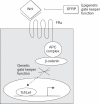Epigenetic changes (aberrant DNA methylation) in colorectal neoplasia
- PMID: 20485652
- PMCID: PMC2871659
- DOI: 10.5009/gnl.2007.1.1.1
Epigenetic changes (aberrant DNA methylation) in colorectal neoplasia
Abstract
Both genetic and epigenetic events have been implicated in the stepwise histological progression involving adenoma-carcinoma and hyperplastic polyp/serrated adenoma-carcinoma sequences in the development of colorectal cancer. Genetic changes have been observed at each step in the initiation and progression of polyps to adenocarcinomas. Epigenetic changes also occur at each step in the pathogenesis of colorectal cancers and include CpG island DNA hypermethylation in the promoter region of genes resulting in transcriptional silencing through associated changes in chromatin structure and effects on binding of transcription factors, and DNA global hypomethylation which leads to chromosomal instability. Recent studies on MLH1 and APC genes indicate that epigenetic and genetic changes cooperate to facilitate tumor initiation and progression. Since aberrant CGI DNA promoter hypermethylation can be detected not only in colorectal polyps and cancers, but also in sera and stool, hypermethylated genes may serve as molecular markers for early detection, risk assessment and diagnosis. In addition, silenced genes caused by CGI DNA promoter hypermethylation can be reactivated by demethylating agents and also by both the inhibitors of DNA methyltransferases and histone deacetylases. Therefore, these epigenetically acting drugs should be evaluated for their chemopreventive and therapeutic potential for colorectal cancers.
Keywords: Colorectal cancer; Colorectal polyps; CpG island; DNA hypomethylation; DNA methylation; Epigenetic changes.
Figures





Similar articles
-
Genome-wide methylation profiling identified novel differentially hypermethylated biomarker MPPED2 in colorectal cancer.Clin Epigenetics. 2019 Mar 7;11(1):41. doi: 10.1186/s13148-019-0628-y. Clin Epigenetics. 2019. PMID: 30846004 Free PMC article.
-
Epigenetic inactivation of a cluster of genes flanking MLH1 in microsatellite-unstable colorectal cancer.Cancer Res. 2007 Oct 1;67(19):9107-16. doi: 10.1158/0008-5472.CAN-07-0869. Cancer Res. 2007. PMID: 17909015
-
Epigenetic events in the colorectum and in colon cancer.Biochem Soc Trans. 2005 Aug;33(Pt 4):684-8. doi: 10.1042/BST0330684. Biochem Soc Trans. 2005. PMID: 16042574 Review.
-
CpG island methylation in precursors of gastrointestinal malignancies.Curr Mol Med. 2006 Jun;6(4):401-8. doi: 10.2174/156652406777435417. Curr Mol Med. 2006. PMID: 16900663 Review.
-
The serrated neoplasia pathway of colorectal tumors: Identification of MUC5AC hypomethylation as an early marker of polyps with malignant potential.Int J Cancer. 2016 Mar 15;138(6):1472-81. doi: 10.1002/ijc.29891. Epub 2015 Oct 30. Int J Cancer. 2016. PMID: 26476272
Cited by
-
Characterizing the prevalence of chromosome instability in interval colorectal cancer.Neoplasia. 2015 Mar;17(3):306-16. doi: 10.1016/j.neo.2015.02.001. Neoplasia. 2015. PMID: 25810015 Free PMC article.
-
No association of CpG island methylator phenotype and colorectal cancer survival: population-based study.Br J Cancer. 2016 Nov 22;115(11):1359-1366. doi: 10.1038/bjc.2016.361. Epub 2016 Nov 3. Br J Cancer. 2016. PMID: 27811854 Free PMC article.
-
MicroRNA-124a and microRNA-34b/c are frequently methylated in all histological types of colorectal cancer and polyps, and in the adjacent normal mucosa.Oncol Lett. 2011 Jan;2(1):175-180. doi: 10.3892/ol.2010.222. Epub 2010 Nov 23. Oncol Lett. 2011. PMID: 22870149 Free PMC article.
-
Different definitions of CpG island methylator phenotype and outcomes of colorectal cancer: a systematic review.Clin Epigenetics. 2016 Mar 2;8:25. doi: 10.1186/s13148-016-0191-8. eCollection 2016. Clin Epigenetics. 2016. PMID: 26941852 Free PMC article.
-
Frequent CpG island methylation: a risk factor in the progression of traditional serrated adenoma of the colorectum.Int J Clin Exp Pathol. 2017 Sep 1;10(9):9666-9674. eCollection 2017. Int J Clin Exp Pathol. 2017. PMID: 31966847 Free PMC article.
References
-
- Fearon ER, Vogelstein B. A genetic model for colorectal tumorigenesis. Cell. 1990;61:759–767. - PubMed
-
- Lengauer C, Kinzler KW, Vogelstein B. Genetic instabilities in human cancers. Nature. 1998;396:643–649. - PubMed
-
- Chung DC. The genetic basis of colorectal cancer: insights into critical pathways of tumorigenesis. Gastroenterology. 2000;119:854–865. - PubMed
-
- Rashid A, Issa JP. CpG island methylation in gastroenterologic neoplasia: a maturing field. Gastroenterology. 2004;127:1578–1588. - PubMed
-
- Kondo Y, Issa JP. Epigenetic changes in colorectal cancer. Cancer and Metastasis. 2004;23:29–39. - PubMed
LinkOut - more resources
Full Text Sources
Other Literature Sources

